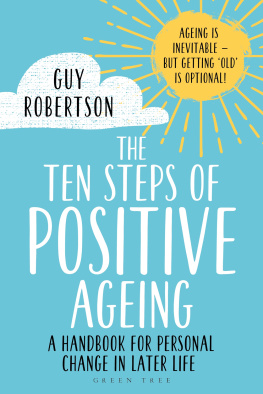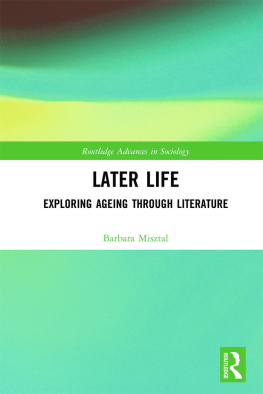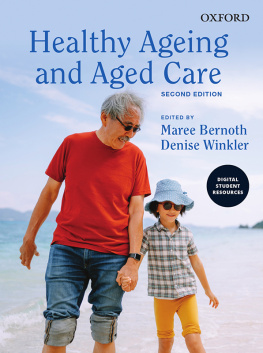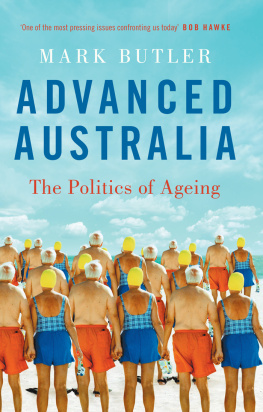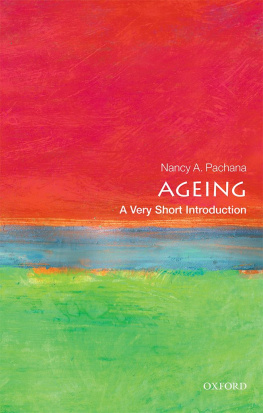
With all my love,
for Fergus, Naomi and Ruth,
without whom none of this would have any meaning.

Contents
.............
Various colleagues have helped me develop my thinking around positive ageing. Worthy of special mention are David Griffiths, with whom I started on the journey, and Miriam Akhtar, who joined in later and with whom I delivered many workshop sessions. I would also like to thank Ian Thomas, Sara Halsey and Jim Cownie, who provided very useful feedback on an early draft. Bloomsbury Publishing have been very supportive and I particularly want to acknowledge the support from Charlotte Croft, Zo Blanc and Helen Williams.
.............
There is nothing older than not wanting to grow old. Our world presents us with a disastrous image of old age. We are afraid of dying badly, of ending our lives alone, unloved, perhaps dependent or suffering from dementia Instead of confronting this fear, we ward it off by clinging to our youth, in a rather pathetic state of denial. In so doing, we run the risk of missing out on what I call the work of growing old that is to say, cultivating a positive awareness of ageing.
These are the first words by Marie de Hennezel, psychologist, psychotherapist and special adviser to the French Government on palliative care, in the preface to her 2008 book with the wonderful title, The Warmth of the Heart Prevents your Body from Rusting. It was de Hennezels book which first inspired me to think about approaches to ageing. Contained within the above quote is the key idea that growing old is something that one needs to work at; there is a job to be done to improve our experience of our own ageing process, and part of that job is to develop a more positive attitude towards ageing. To me, at that time, this was revolutionary. Her central notion that we can have more control over our ageing process than we might otherwise think, is still far from being a mainstream idea. I hope that this book will go a little way to help you recognise this important truth about ageing.
The prospect for people over 60 has never looked as promising as it does now! On average, men and women at retirement age can expect to live for a further 20 years, and for most of that time they are likely to be in good health. But its not just a matter of living longer; the over 60s can actually look forward to a whole new phase in life a period that could be longer than all the time spent at school and university.
This new phase is filled with great potential, with plenty of opportunities for learning, engaging in new activities, travelling, giving back to society and being creative. We can make the best of this time if we approach it with a positive mental attitude and make some simple preparations. The Ten Steps of Positive Ageing offers a route map to help you find your way, as well as providing a toolkit of personal development exercises and self-evaluation questionnaires which can support you on your positive ageing path.
This book is probably unlike any other book you have read on ageing. I dont look at the common concerns of such books, like exercise or diet. Both are extremely important but there is no need for them to be covered here as there is already so much good quality information and guidance available elsewhere. Instead, this book concentrates purely on the psychological and emotional aspects of ageing. This inner world of ageing is seldom talked or written about despite the fact that it is our internal thoughts and feelings which determine our wellbeing in later life. Think of this as a specially designed workbook, based on solid research evidence, to help you explore this world. By following it, you will be equipped to develop your own vision of the later life you would ideally like, along with the practical steps to achieve it.
Just as we had to learn to grow up, so we have to learn to grow old. If we dont put some thought and attention into preparing for these years, then we could very easily feel short-changed or disappointed. However, if we take some time to look closely at the issues, we are much more likely to age well and reap the benefits.
The Ten Steps are signposts to key areas of life that you should consider in order to age more positively. They are not exactly prescriptions; they are more like invitations to pay attention to different features of your inner world principally the thoughts and feelings that occupy you as you age.
The book starts by looking at the different notions of ageing and how it affects our lives, and outlines what we mean by the concept of positive ageing the most important point being that we have more control over our ageing than we think.
The actual Ten Steps dive right in at the deep end by focusing on death and the way in which consideration of mortality can actually enliven and bring more joy and satisfaction to our lives. The next step is to conduct a reality check on all the negative ideas and images about ageing and test out whether we are actually getting a balanced picture of its positive as well as the negative aspects. ) which exemplify the positive ageing philosophy.
The material in this book is backed up by peer-reviewed published research, the details of which you can find in the References section. Each step provides an overview of the most recent and relevant data on the topic, along with self-evaluation questionnaires and practical personal development exercises.
The questionnaires can give you useful insights into your own thoughts and feelings about various issues. When completing the questionnaires, it is best not to over think how to answer them. Just act on your first reactions there are no right answers, just the opportunity to increase your self-knowledge. And if you get a score that you dont like dont let it worry you or get you down. See it instead as an opportunity to use the exercises and the information in the chapter to address the issues you are struggling with. The exercises are designed to provide you with powerful tools for enhancing your experience of ageing. You can do them just on your own, but many of them lend themselves to being done with other people. In fact, sharing your positive ageing journey with others can be a very powerful way of bringing about personal change.
The book is designed as a workbook rather than a coffee table exhibit! Highlight the information that you find interesting, complete the questionnaires, and feel free to scribble down some of the insights, realisations or resolutions you gain from the exercises. If you dont want to mark the book itself then have a paper and pen to hand.
I believe that by using the material here, you will be able to take greater control of your ageing process and begin to create the kind of later life you want. There are no certainties, but I believe that the research evidence is sufficiently strong for you to be confident that following this approach will increase your chances of improving your health and wellbeing in later life.
Ageing is a process, not a crisis. There has never been a better time to age!
.............
You know youre getting old when the candles cost more than the cake.
BOB HOPE, American comedian and actor
Before we start you might like to answer the following questions:
How old do you feel you are?
How old would you like to be?

